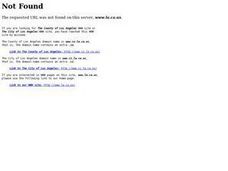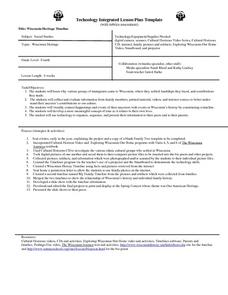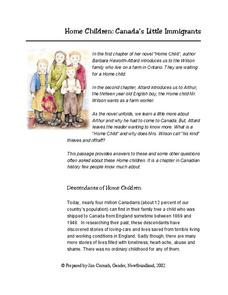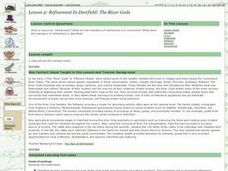PBS
Family History: On Your Honor
What is your history? Scholars work with their own families to create a unique story of the courage and bravery of their ancestors. The third and final part of the series culminates in a creation of not just a family history, but a...
Curated OER
Family Genealogy
Students create a family tree. In this genealogy lesson, students research their family history and create a pictorial representation of their family tree. Students use the computer to design the layout and scan pictures.
All for KIDZ
The Orphan of Ellis Island
Everyone comes from somewhere. An interdisciplinary lesson on Elvira Woodruff's The Orphan of Ellis Island includes discussion starter and writing prompts for the novel, as well as a graphic organizer to help learners begin their...
Curated OER
Where Were Your Ancestors in 1871?
Here is a nicely designed lesson on ancestry and family history. In it, learners read an article entitled, "Where Were Your Ancestors in 1871?" Then, they make up a series of questions to profile their family and their community 100...
Curated OER
A Family History
Students investigate their family history through pictures and writing. In this family history lesson, students research family, culture, food, music, religion, and clothing. Students gather pictures of their family and events. Students...
Curated OER
Investigating Immigration and Settlement in Wisconsin
Fourth graders identify the origins of their own ancestors and possible reasons for immigration. They research immigrant groups of Wisconsin, including origins and daily life, and then create timelines depicting their settlements.
Curated OER
Genealogy Research
Students explore history is not as a listing of dates, wars, and leaders but as the story of real people whose lives were impacted by the events of their time. They complete a pedigree chart and tape record a family member.
NET Foundation for Television
1850-1874 Homestead Act Signed: Who were the Settlers?
Life in the great, wide-open spaces of the West! Scholars analyze the reasons behind the vast movement to the Great Plains after the passing of the Kansas-Nebraska Act and the Homestead Act. Using photographic, document, map, video, and...
Curated OER
European Immigrant Journey Museum
Second graders write a five sentence paragraph about what one special item / toy they would pack in the family trunk to take with them on their trip to the new world. They research family history finding names of parents and grandparents...
Curated OER
Comparing Family Photos
Fourth graders bring in a family photo from home. They compare their photo to the Rawding family photo. Students share their conclusions orally. They use Venn Diagrams to organize their thoughts and observations.
Indian Land Tenure Foundation
A Sense of Belonging
In order to understand how the land changes over time because of the people who live there, learners interview an elderly person about the past. Children ask an older family member to describe what the local area was like when they were...
Curated OER
Discovering Your Heritage
Students interview a family member about their heritage. They listen to and record part of their family's oral history. Students also create and label a family tree going back a minimum of two generations and compare and contrast...
Curated OER
Ellis Island Online
Learners research their ancestors by visiting a number of online resources. They read personal immigration stories and begin creating their own family tree.
Curated OER
Immigration
Fifth graders write a 2-3 page essay explaining the problems of refugees in the world today. They explain where in the world this is happening, why the refugees are leaving their homeland, where they are going, and what happens to them...
Curated OER
What's In a Name?
Students explore the relationship between names and certain cultures and locations. In this identity lesson, students create family migration or immigration maps. Students read excerpts from When My Name was Keoko and Lost Names: Scenes...
Curated OER
Where I Come From
Students discuss the countries and cultures that are part of their family history. They research the country their family "came from" and write a report.
Curated OER
Genealogy Research
Personalize history through genealogy. Get your scholars examining their family's past by utilizing resources at your local genealogical society. Learners complete family pedigree charts and choose to do one of the following: research...
Curated OER
The American Rainbow
Third graders are introduced to the concept of ancestry. Using their own family, they gather information related to the family roots. In groups, they locate the countries on a map and discuss the concept of migration. They identify...
Curated OER
Wisconsin Heritage Timeline
Fourth graders explore why groups of immigrants settled in Wisconsin. Through intervies with family members, printed materials, and internet research, 4th graders discover the contributions early residents made to the state. Students...
Curated OER
Games Children Play
Help your middle schoolers recognize the similarities and differences between the games they play and those played by pioneer children. Using the Internet, they research a game of their choice and discover how it has evolved over time....
Curated OER
Who Were the Settlers?
Students examine why people move from one country or area to another. Using photographs, they analyze the culture and lifestyles of people pictured in the image. They research and explain the daily experiences of the settlers to...
Curated OER
Home Child History
In this Language Arts worksheet, students read about Canadian history related to the novel Home Child. Students read about the story of Canada's Home children, which began in the mid-1800's.
Curated OER
Refinement in Deerfield: The River Gods
Students research the town of Deerfield, CT and its River God families to show how the middle class developed in the Connecticut River Valley.
Curated OER
The Homestead Act of 1682
In this American West activity, learners read about the Homestead Act of 1682. Students read 8 paragraphs and complete the 3 activities for the activity.

























